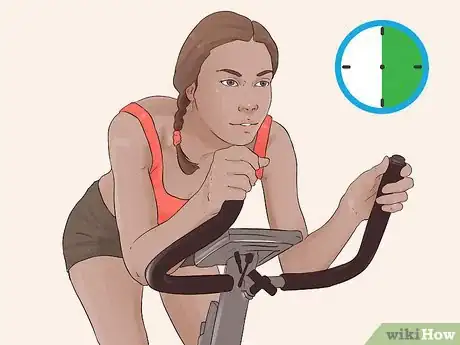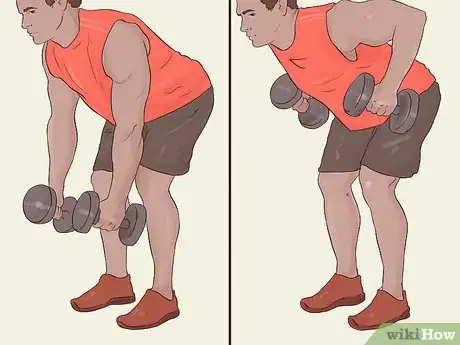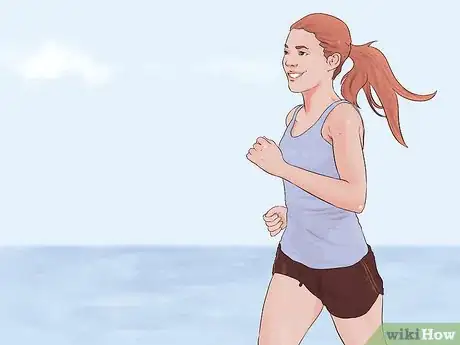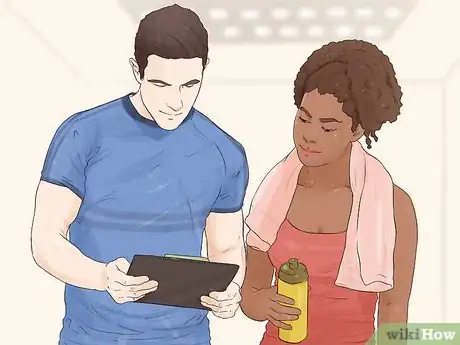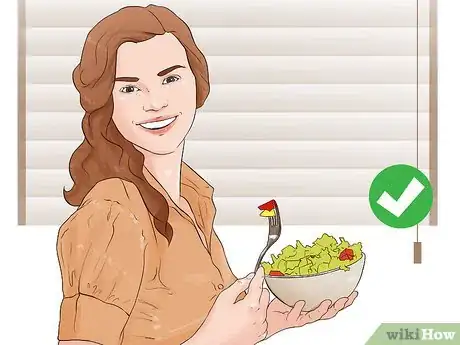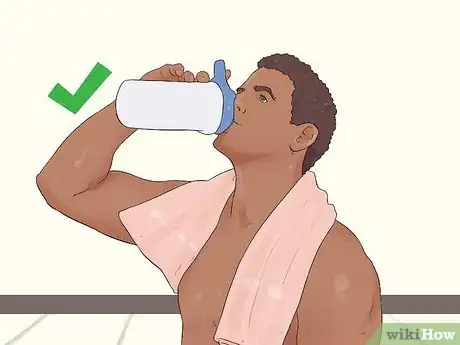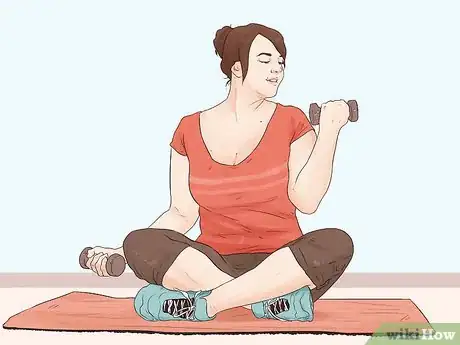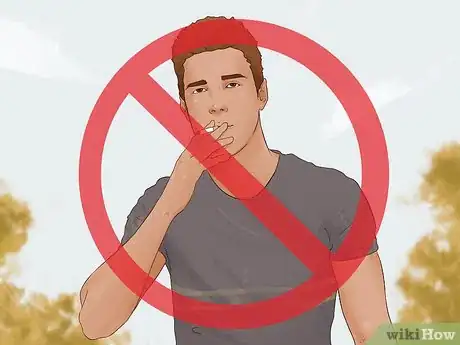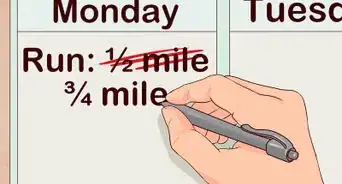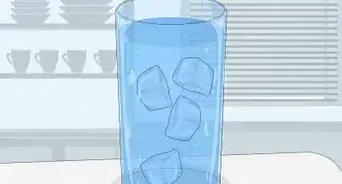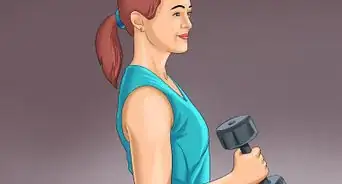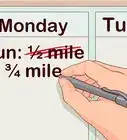This article was co-authored by Danny Gordon. Danny Gordon is an American College of Sports Medicine (ACSM) Certified Personal Trainer and Owner of The Body Studio for Fitness, a fitness studio based in the San Francisco Bay Area. With over 20 years of physical training and teaching experience, he has focused his studio on semi-private personal training. Danny received his Personal Trainer Certification from the California State University, East Bay and the American College of Sports Medicine (ACSM).
There are 8 references cited in this article, which can be found at the bottom of the page.
This article has been viewed 184,575 times.
Are you ready to get fit but aren't totally sure where to start? Getting into physical fitness for the first time or jumping back into things after an extended break can feel overwhelming, but it doesn't have to. This article will walk you through simple, concrete (and most importantly, effective) steps you can take to start improving your fitness and feeling better physically and mentally. No crazy diets or insane workout routines are required.
Steps
Increasing Your Physical Activity
-
1Include 30 minutes of cardiovascular activity most days. Cardiovascular activity is an essential part of any plan to improve physical fitness.[1] Exercising for 150 minutes per week (or 30 minutes five days per week) is recommended, so try to make this amount of activity part of your schedule.[2]
- As an alternative, you may do 75 minutes of vigorous cardiovascular activity. For example, you could do 15 minutes of kickboxing, stair climbing, or running five days out of every week.
- Keep in mind that exercising for longer is better. If you can fit in 300 minutes of moderate aerobic activity each week, then you will gain more health benefits than if you exercise for 150 minutes per week.
-
2Add strength training. Strength training is also essential for physical fitness, but you only need to do two strength training workouts each week. Make sure that these two workouts target all of your major muscle groups, including your abs, arms, back, chest, hips, legs, and shoulders. Both workout groups don't have to focus on all muscle groups at once.[3]
- For example, one workout can focus on your arms, back, chest, and shoulders. The other workout can focus on your abs, hips, and legs.
Advertisement -
3Take a class. Exercise classes provide a good workout and a social outlet as well. Group exercise classes may also help you to stay motivated more than working out on your own.[4] Try taking an exercise class such as:
- Spinning
- Zumba
- Step
- Yoga
- Tai chi
- Pilates
-
4Find little ways to move more. Adding more small bursts of physical activity into your day may also help to improve your physical fitness levels. Even if you only have a few minutes, you can take advantage of this time and get a little extra physical activity into your day.[5]
- For example, you could do some sit-ups during a commercial break, park your car further away from the entrance at the grocery store, or take the stairs instead of the elevator. All of these little changes will help to improve your cardiovascular health and build your strength.
-
5Set goals. Having a fitness goal or a series of little goals that you are working towards will help you to stay focused and may even help to keep you motivated.[6] Make sure that you set goals that are SMART (specific, measurable, action-oriented, realistic, and time-based).[7]
- For example, if you want to exercise every day, you might set your goal as something like, “I will go for a brisk 30-minute walk every morning this week.”
-
6Track your progress. Keeping track of your fitness progress is a great way to stay motivated. Tracking your progress can also make it easier to see when you reach a fitness goal. You can track your progress in lots of different ways. Some tracking methods for physical fitness include:
- Weight and/or body measurements
- Mile time
- How much weight you can lift
- Number of sit-ups/push-ups you can do
- Your ability to hold a difficult pose, such as a plank, for a certain amount of time
-
7Start small. Although it is rare, jumping right into vigorous exercise after being sedentary for a long time can increase your risk of having a heart attack; therefore, it is best to go slow and start with something less intense, such as walking, swimming, or biking.[8]
- Starting slow will also help to reduce your chances of getting injured, which can put a hold on your fitness efforts.
- After a while, you can increase your activity intensity and duration, such as from walking to jogging, or biking on a flat surface to biking on a somewhat hilly surface, or swimming for 45 minutes instead of 30 minutes.[9]
- Starting with small, more easily-achieved goals helps people stick with their plans. Drastic changes are harder to stick with — find something that you enjoy and seems doable.
-
8Consider working with a personal trainer. If you have a hard time staying motivated or if you just are not sure where to start, a trainer can help you. Working with a trainer can give your fitness efforts a good jump start and work with a trainer may also make it easier to stick with your program.
- A personal trainer can also teach you some effective workout strategies to keep you interested and seeing results. Some personal trainers will also provide you with meal plan ideas and advice about how to maximize your results.
Improving Your Eating Habits
-
1Determine how many calories you need to eat per day. To improve your physical fitness, you will also need to pay careful attention to your diet. If you are trying to lose weight, then you will need to eat fewer calories than you burn. If you are trying to gain weight, then you will need to eat more.[10]
- Keep track of everything you eat. Whether you need to lose weight or gain weight, you will need to keep careful track of how much food you take in every day. Try starting a food diary to keep track of your caloric intake.
- Measure your food. Measuring your food is important to ensure that you are not overestimating or underestimating how much food you are taking in on a daily basis. Read the labels on everything you eat and measure out appropriate portions to ensure that you are getting the right amount of calories every day.
-
2Follow a balanced diet. What you put into your body can make a big difference in your results and how you feel. That is why it is important to follow a balanced diet as you work towards your fitness goals. Some things that you should include in your diet are:[11]
- Fruits and vegetables, such as bananas, apples, oranges, broccoli, spinach, carrots, and peppers.
- Lean protein, such as skinless chicken, wild sockeye salmon, lean cuts of grass-fed beef, seeds, nuts, eggs, soy, dairy, beans, lentils, and chickpeas. Some grains are also good sources of lean protein, such as quinoa, hemp, amaranth, buckwheat, and chia.
- Complex carbohydrates, such a brown rice, whole wheat pasta, whole wheat bread, and quinoa.[12]
-
3Eliminate unhealthy choices. As you work to include healthier foods in your diet, you should also do what you can to eliminate unhealthy choices. Try to reduce your intake of foods that:[13]
- Are high in sugar and/or trans fats, such as sugary cereals, candy, and baked goods.
- Are greasy or fried, such as onion rings, French fries, and deep-fried fish
- Are highly processed, such as canned soups, crackers, and frozen dinners
-
4Drink lots of water. Drinking water will help you stay hydrated and it can also help you to eat less by filling up your stomach temporarily.[14] Try to drink eight 8-ounce (250-ml) glasses of water every day to stay hydrated.
- If you have been exercising, then you will need to drink more water to replace the water that your body has lost.
- Try swapping water for the beverages that you normally drink, such as juice, soda, and coffee.
Making Lifestyle Changes
-
1See your doctor. Before you make any major changes to your activity level or diet, you may want to schedule an appointment with your doctor. Some people have restrictions on diet and exercise levels based on medical conditions, so it is best to check with your doctor before you make major changes to your diet or activity levels.
- Do not rely on the internet to tell you what restrictions you have based on your medical condition. Each condition is unique; your doctor will know you the best.
-
2Lose weight if you are overweight. Being overweight puts you at a higher risk of developing chronic diseases, such as diabetes, and it may also be preventing you from being as physically fit as you could be. If you are carrying extra weight, then you may want to consider starting a weight loss program.
- Keep in mind that you don’t need to lose a ton of weight to see health benefits. Even losing 5% to 10% of your total body weight can help to reduce your blood pressure, lower cholesterol, and improve your blood sugar levels.[15]
-
3Quit smoking. Smoking can interfere with your fitness goals and it can also lead to life-threatening diseases such as cancer, emphysema, and COPD. If you smoke, then talk to your doctor about treatment options that might make it easier for you to quit. There are prescription medications and smoking cessation programs that may help you to stop smoking.
- Not every treatment may work for you. You may have to try several before you find the right one.
- Don't expect treatments to work immediately. Some require several weeks before you start seeing any significant results.
-
4Cut down on alcohol. Drinking large amounts of alcohol can also make it hard for you to improve your physical fitness. Alcohol adds empty calories to your diet and it can also cause dehydration, fatigue, and other health problems. Do not consume more than one drink per day if you are a woman and no more than two drinks per day if you are a man.[16]
- If you often binge drink and/or find it hard to moderate your alcohol intake, then you may want to talk to your doctor. You may need to seek treatment to help you stop drinking.
Sample Goals, Exercises, and Workout
Expert Q&A
Did you know you can get expert answers for this article?
Unlock expert answers by supporting wikiHow
-
QuestionHow does exercise improve physical fitness?
 Danny GordonDanny Gordon is an American College of Sports Medicine (ACSM) Certified Personal Trainer and Owner of The Body Studio for Fitness, a fitness studio based in the San Francisco Bay Area. With over 20 years of physical training and teaching experience, he has focused his studio on semi-private personal training. Danny received his Personal Trainer Certification from the California State University, East Bay and the American College of Sports Medicine (ACSM).
Danny GordonDanny Gordon is an American College of Sports Medicine (ACSM) Certified Personal Trainer and Owner of The Body Studio for Fitness, a fitness studio based in the San Francisco Bay Area. With over 20 years of physical training and teaching experience, he has focused his studio on semi-private personal training. Danny received his Personal Trainer Certification from the California State University, East Bay and the American College of Sports Medicine (ACSM).
Certified Personal Trainer
-
QuestionWhat does your metabolism have to do with your fitness?
 Danny GordonDanny Gordon is an American College of Sports Medicine (ACSM) Certified Personal Trainer and Owner of The Body Studio for Fitness, a fitness studio based in the San Francisco Bay Area. With over 20 years of physical training and teaching experience, he has focused his studio on semi-private personal training. Danny received his Personal Trainer Certification from the California State University, East Bay and the American College of Sports Medicine (ACSM).
Danny GordonDanny Gordon is an American College of Sports Medicine (ACSM) Certified Personal Trainer and Owner of The Body Studio for Fitness, a fitness studio based in the San Francisco Bay Area. With over 20 years of physical training and teaching experience, he has focused his studio on semi-private personal training. Danny received his Personal Trainer Certification from the California State University, East Bay and the American College of Sports Medicine (ACSM).
Certified Personal Trainer
-
QuestionWhat types of food will add body weight?
 Michele DolanMichele Dolan is a BCRPA certified Personal Trainer in British Columbia. She has been a personal trainer and fitness instructor since 2002.
Michele DolanMichele Dolan is a BCRPA certified Personal Trainer in British Columbia. She has been a personal trainer and fitness instructor since 2002.
Certified Fitness Trainer All foods (except perhaps some vegetables like celery and cabbage) will add body weight if consumed in large enough portions. If you are trying to gain weight, look at increasing your healthy fats with foods like nuts, avocados or fish. To gain muscle you'll have to eat more protein. It is important to keep nutrition high so don't skip lower calorie foods like vegetables, but do try to increase calorie intake to gain weight.
All foods (except perhaps some vegetables like celery and cabbage) will add body weight if consumed in large enough portions. If you are trying to gain weight, look at increasing your healthy fats with foods like nuts, avocados or fish. To gain muscle you'll have to eat more protein. It is important to keep nutrition high so don't skip lower calorie foods like vegetables, but do try to increase calorie intake to gain weight.
References
- ↑ Danny Gordon. Certified Fitness Coach. Expert Interview. 18 October 2019.
- ↑ http://www.cdc.gov/physicalactivity/basics/adults/
- ↑ Danny Gordon. Certified Fitness Coach. Expert Interview. 18 October 2019.
- ↑ http://whatworksforhealth.wisc.edu/program.php?t1=21&t2=12&t3=79&id=501
- ↑ Danny Gordon. Certified Fitness Coach. Expert Interview. 18 October 2019.
- ↑ Danny Gordon. Certified Fitness Coach. Expert Interview. 18 October 2019.
- ↑ http://www.move.va.gov/docs/NewHandouts/Standard/S02_SetYourWeightLossGoals.pdf
- ↑ http://www.cdc.gov/physicalactivity/basics/pa-health/
- ↑ Danny Gordon. Certified Fitness Coach. Expert Interview. 18 October 2019.
- ↑ Danny Gordon. Certified Fitness Coach. Expert Interview. 18 October 2019.
- ↑ Danny Gordon. Certified Fitness Coach. Expert Interview. 18 October 2019.
- ↑ http://www.helpguide.org/articles/healthy-eating/healthy-eating.htm
- ↑ http://www.helpguide.org/articles/healthy-eating/healthy-eating.htm
- ↑ http://www.helpguide.org/articles/healthy-eating/healthy-eating.htm
- ↑ http://www.cdc.gov/healthyweight/losing_weight/
- ↑ http://www.mayoclinic.org/healthy-lifestyle/nutrition-and-healthy-eating/in-depth/alcohol/art-20044551
About This Article
Improving your physical fitness can seem challenging, but by taking small steps to improve your exercise and eating habits, you can do it! You should aim to do 30 minutes of cardiovascular exercise 5 days a week. Try jogging, kickboxing, stair-climbing, or any exercise you enjoy that gets your heart-rate up! It can help to download a fitness app to keep track of your progress and encourage you to meet your goals. If you don’t have time to exercise on certain days, try finding small ways to get yourself moving. For example, take the stairs instead of the elevator, or do sit-ups during commercial breaks. Besides exercising, you’ll want to eat a balanced diet of lean proteins, fruits, vegetables, and complex carbohydrates. Try to stay away from unhealthy foods like fries, candy, and baked goods, since these aren't a good source of nutrients. To learn how to make other lifestyle changes to improve your fitness, read on!
